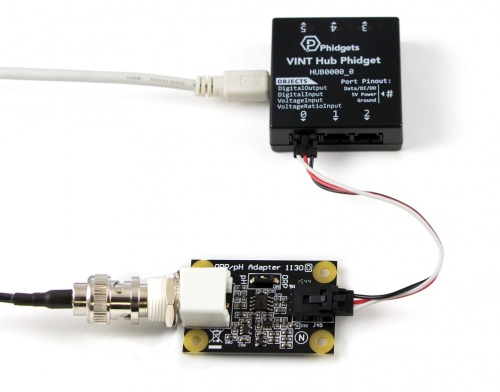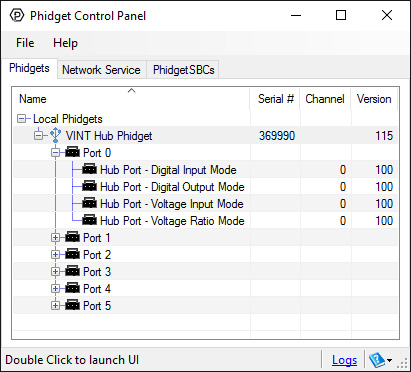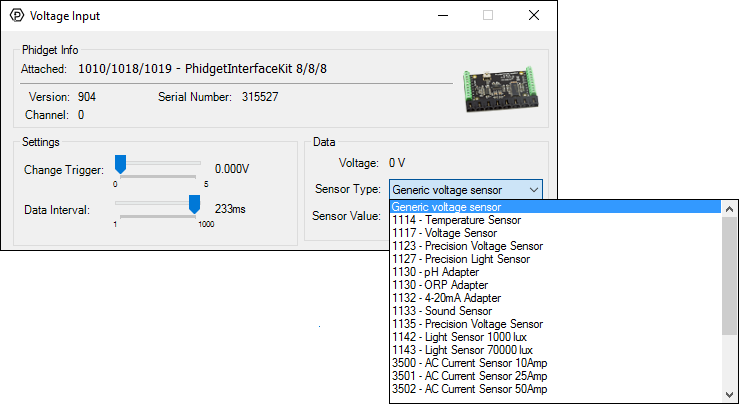PH/ORP Sensor Guide
Learn about pH and ORP in this guide, including: how pH/ORP probes work, how to interface with pH/ORP probes, how to care for probes, and more.


This product is a pH/ORP interface. It connects to BNC-style electrodes and outputs a ± 400mV or ±2V signal, depending on the mode. This signal can be read easily by a VINT Hub Phidget, or any Phidget with an analog input.
Welcome to the 1130 user guide! In order to get started, make sure you have the following hardware on hand:
Next, you will need to connect the pieces:

Now that you have everything together, let's start using the 1130!
In order to demonstrate the functionality of the 1130, we will connect it to the HUB0000, and then run an example using the Phidget Control Panel on a Windows machine.
The Phidget Control Panel is available for use on both macOS and Windows machines. If you would like to follow along, first take a look at the getting started guide for your operating system:
Linux users can follow the getting started with Linux guide and continue reading here for more information about the 1130.
After plugging in the 1130 into the HUB0000, and the HUB0000 into your computer, open the Phidget Control Panel. You will see something like this:

The Phidget Control Panel will list all connected Phidgets and associated objects, as well as the following information:
The Phidget Control Panel can also be used to test your device. Double-clicking on an object will open an example.
Double-click on a Voltage Input object in order to run the example:

General information about the selected object will be displayed at the top of the window. You can also experiment with the following functionality:
The Phidget libraries can automatically convert sensor voltage into pH by selecting the appropriate SensorType. See the Phidget22 API for more details. To determine the pH of a solution, make sure the DIP switch on the board is flipped to the pH side. Given the voltage from the sensor, the following formula can be applied:
This formula (and the Phidget library Sensor Value formula) assumes that the solution is at 25°C. Depending on the temperature of the solution and on the actual pH level, the output voltage can change dramatically. To incorporate temperature (in °C) for added accuracy, the following formula can be used:
The following example is to give an idea of how the temperature affects the output voltage:
| Temperature (°C) | pH | Voltage (V) |
| 0 | 2 | 1.21 |
| 25 | 2 | 1.095 |
| 100 | 2 | 0.74 |
| 0 | 8 | 2.76 |
| 25 | 8 | 2.78 |
| 100 | 8 | 2.85 |
As shown above, temperature has a greater impact on solutions that have a pH further away from the reference pH of 7. Temperature also affects the impedance of the glass electrode, and can result in increased errors if not properly calibrated. If you want to monitor the temperature of the solution, you can use a thermocouple. You'll need to add some sort of protective shielding to the thermocouple if you’re using acidic or basic solutions, though. Check out our thermocouple interfaces for more information.
The Phidget libraries can automatically convert sensor voltage into ORP by selecting the appropriate SensorType. See the Phidget22 API for more details. To determine the ORP of a solution, make sure the DIP switch on the board is flipped to the ORP side. Given the voltage from the sensor, the following formula can be applied:
ORP electrodes give a typical range of -2V to 2V, where the positive values are for oxidizers and the negative values are for reducers.
The 1130 should be used to measure solutions that are electrically quiet. Measuring pH in electrically noisy environments such as tanks with mixing pumps, and even other measuring devices is not recommended.
Review the data sheet for the electrode you have selected for your application to ensure that it complies with the device specifications of the 1130. The important specification is the output voltage of the electrode. Many electrodes will work but it is important to verify compliance before connecting an electrode to the 1130. In fact, any type of sensor that uses a BNC connector and complies with the voltage range of the 1130 should work. We have reviewed the following electrodes, and found that they can be used with the 1130. This is by no means a comprehensive list, but can be used as a comparison with other electrodes if necessary.
| Manufacturer | Part Number |
| Omega | PHE13XX, PHE14XX, ORE1311, ORE1411 |
| Cole-Parmer | EW-59001, EW27003 |
| Mettler-Toledo | InLab (BNC) Series |

The Phidget Cable is a 3-pin, 0.100 inch pitch locking connector. Pictured here is a plug with the connections labelled. The connectors are commonly available - refer to the Analog Input Primer for manufacturer part numbers.
For more information on pH and ORP probes, check the PH/ORP Sensor Guide.
| Sensor Properties | |
|---|---|
| Controlled By | Voltage Input (0-5V) |
| Sensor Output Type | Non-Ratiometric |
| pH Specifications | |
| pH Input Range | ± 400 mV DC |
| pH Resolution | 0.018 |
| pH Error Max | ± 0.09 |
| ORP Specifications | |
| ORP Input Range | ± 2 V DC |
| ORP Resolution | 5 mV DC |
| ORP Error Max | ± 8 mV DC |
| Board Properties | |
| Current Consumption Max | 3 mA |
| Input Impedance | 1 TΩ |
| Supply Voltage Min | 4.5 V DC |
| Supply Voltage Max | 5.3 V DC |
| Connector Thread Size | ½-28UNEF-2A |
| Customs Information | |
| Canadian HS Export Code | 8473.30.00 |
| American HTS Import Code | 8473.30.11.80 |
| Country of Origin | CN (China) |
| Date | Board Revision | Device Version | Comment |
|---|---|---|---|
| March 2010 | 0 | N/A | Product Release |
This device doesn't have an API of its own. It is controlled by opening a VoltageInput channel on the Phidget that it's connected to. For a list of compatible Phidgets with Voltage Inputs, see the Connection & Compatibility tab.
You can find details for the VoltageInput API on the API tab for the Phidget that this adapter connects to.
The Phidgets pH/ORP Adapter can connect to one pH or ORP electrode that uses a BNC connector. The electrodes in the table below are all compatible with this adapter. If you plan on using your own electrode, we recommend that you contact Phidgets Support to determine if it will be compatible with this adapter.
| Product | Electrode Properties | Physical Properties | ||
|---|---|---|---|---|
| Part Number | Price | Electrode Type | Operating Temperature Max | Exterior Tube Material |
 pH Lab Electrode
|
$25.00 | Combination Single-Junction (pH) | 80 °C | Impact Resistant Plastic |
This sensor can be read by any Phidget with an Analog Input or VINT Hub port. It will connect to either one using a Phidget cable. VINT Hub ports can behave just like Analog Inputs, but have the added flexibility of being able to be used as digital inputs, digital outputs, or ports to communicate with VINT devices. For more information about VINT, see the VINT Overview page.
| Product | Voltage Inputs | ||
|---|---|---|---|
| Part Number | Price | Number of Voltage Inputs | Voltage Input Resolution (bits) |
 VINT Hub Phidget
|
$40.00 | 6 (Shared) | *** 15 bit |
 1-Port VINT Hub Phidget
|
$26.00 | 1 (Shared) | ** 16 bit |
 VINT Hub Phidget
|
$35.00 | 6 (Shared) | * 15 bit |
 Wireless VINT Hub
|
$65.00 | 6 (Shared) | * 16 bit |
 PhidgetSBC4
|
$130.00 | 6 (Shared) | * 16 bit |
 PhidgetInterfaceKit 8/8/8
|
$90.00 | 8 | — |
 PhidgetInterfaceKit 2/2/2
|
$50.00 | 2 | 10 bit |
 8x Voltage Input Phidget
|
$22.00 | 8 | 12 bit |
 PhidgetInterfaceKit 8/8/8
|
$90.00 | 8 | 10 bit |
 PhidgetInterfaceKit 8/8/8 Mini-Format
|
$70.00 | 8 | 10 bit |
 PhidgetInterfaceKit 8/8/8 w/6 Port Hub
|
$110.00 | 8 | 10 bit |
 PhidgetTextLCD 20X2 : White : Integrated PhidgetInterfaceKit 8/8/8
|
$70.00 | 8 | 10 bit |
This sensor requires a Phidget cable to connect it to an InterfaceKit or Hub. You can solder multiple cables together in order to make even longer Phidget cables, but you should be aware of the effects of having long wires in your system. See a full list of Phidget cables below.
| Product | Physical Properties | |
|---|---|---|
| Part Number | Price | Cable Length |
 Phidget Cable 10cm
|
$1.50 | 100 mm |
 Phidget Cable 30cm
|
$1.75 | 300 mm |
 Phidget Cable 60cm
|
$2.00 | 600 mm |
 Phidget Cable 60cm
|
$2.00 | 600 mm |
 Phidget Cable 90cm
|
$2.00 | 900 mm |
 Phidget Cable 120cm
|
$2.25 | 1.2 m |
 Phidget Cable 150cm
|
$2.50 | 1.5 m |
 Phidget Cable 180cm
|
$2.75 | 1.8 m |
 Phidget Cable 350cm
|
$3.00 | 3.5 m |
 Phidget Cable Kit
|
$10.00 | 80 mm |
 Phidget Cable Extension Wire 22AWG
|
$0.75/Meter | — |